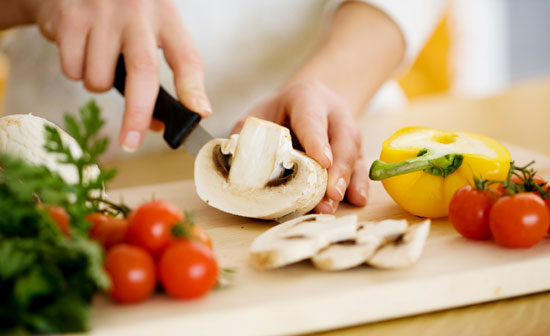Whether you’re eating smaller meals several times a day or sticking to the daily triple, nutrition and fitness experts recommend using the USDA MyPlate as your guide for a balanced, nutritious diet. Be sure to eat foods from each of the food groups daily. Eat a variety of foods in each group to ensure you get all the nutrients you need and keep a close watch on your calcium and iron intake.
MyPlate breakdown:
- Grain Group: six ounce-equivalents or servings each day. Choose at least three that are whole grain.
- Vegetable Group: 2.5 cups total for five servings each day. Choose a variety of vegetables of different colors, including dark green and orange.
- Fruit Group: 2 cups total for four servings each day. Choose a variety of fruits of different colors.
- Milk Group: 3 cups each day. Yogurt, milk, and cheese (low-fat or fat-free versions are best).
- Meats and Beans Group: 5.5 ounces total for two or three servings each day. Lean meats, chicken, eggs, nuts, dried beans and peas, and fish.
- Oils: six teaspoons or servings each day. Choose mono- and polyunsaturated oils.
- Discretionary Calories: a small amount. An allotment of 100 to 300 calories can be used on foods with fats or sugars, like dessert.
You Can Snack, Too
Be sure to enjoy light, low-fat snacks throughout the day to keep your energy and blood sugar level up. This is especially important if you work out later in the day or have a tendency to skip meals due to an overloaded schedule. The following snack guide can help you choose what to have and how often.
EVERY DAY: Bagels, Cut-up vegetables, Fat-free flavored rice cakes, Low-fat yogurt
SOMETIMES: Cheese, Crackers, Frozen yogurt, Graham crackers, Granola bars, Light popcorn, Nuts, Pretzels
SPECIAL OCCASION: Candy, Candy bars, Chocolate, Cookies, Ice cream, Potato chips
Drink Up
Water is the most important nutrient for an athlete. About 50-70 percent of you is water. Water keeps you cool in the summer and warm in the winter. It eliminates waste from the body and keeps your joints and internal organs lubricated. Eight 8-oz. glasses of water per day is the recommended minimum – more if you are very active.
If you play soccer for a couple of hours on a hot summer day, your internal reservoir may become dangerously low, causing dehydration and limiting your performance. If you wait until your thirst kicks in to start the quenching process, you’re already too late. You’ve got to drink before, during, and after your workout. During prolonged aerobic exercise, drink four to six ounces of fluids (preferably water) every 15 minutes. Sports drinks can be used if your workout lasts longer than 90 minutes, since the sugar concentration lengthens the time it takes to empty from your stomach. For shorter workouts, stick with water.

